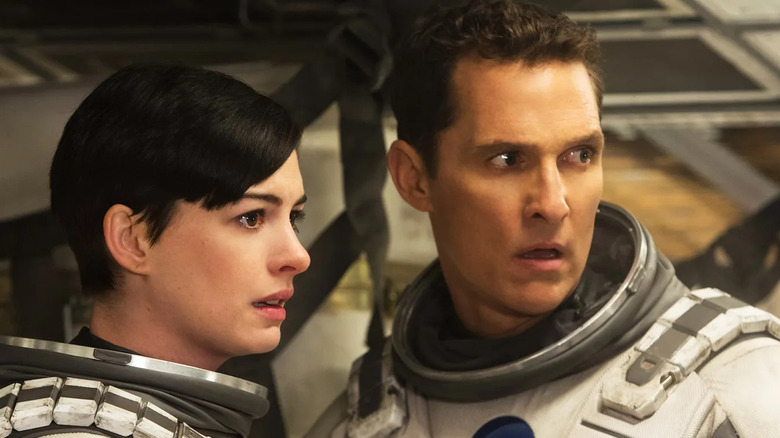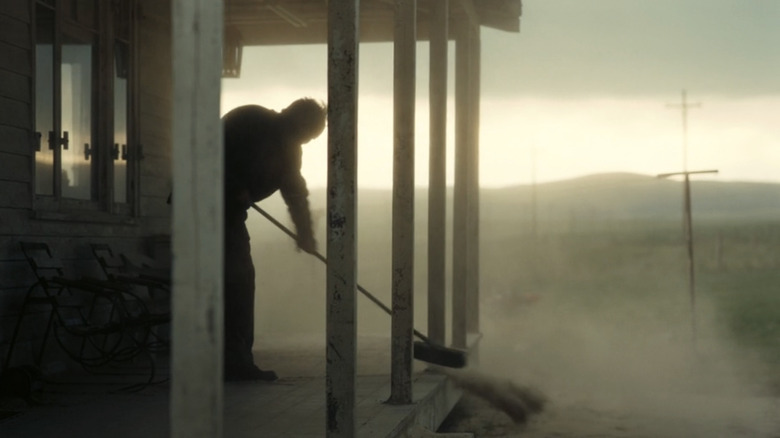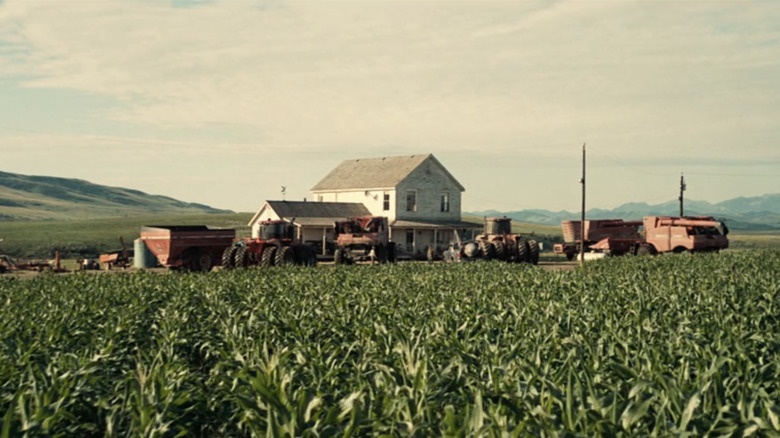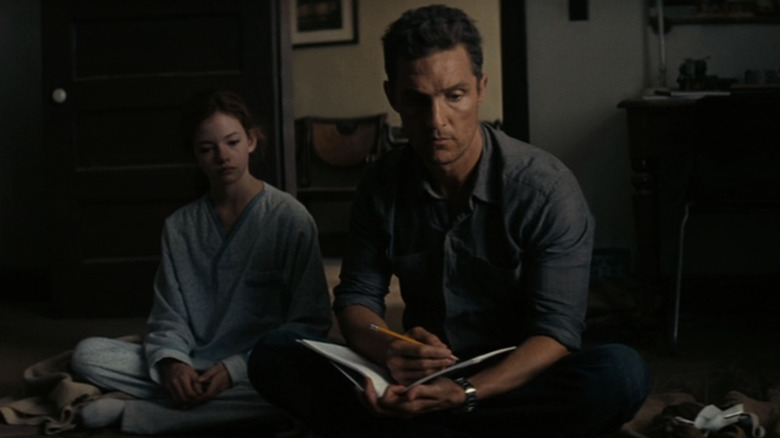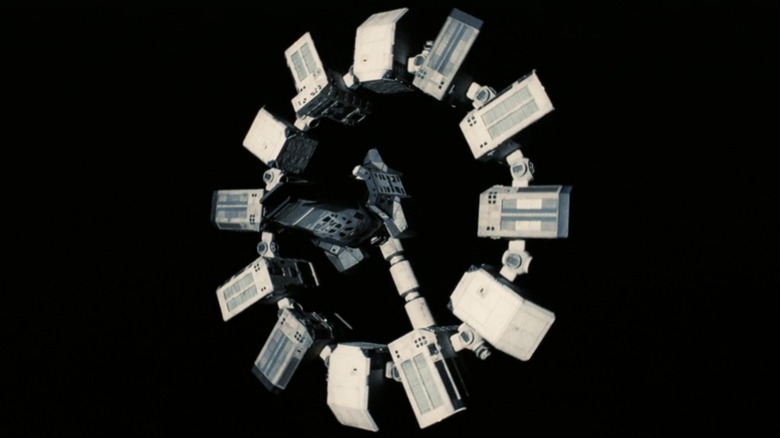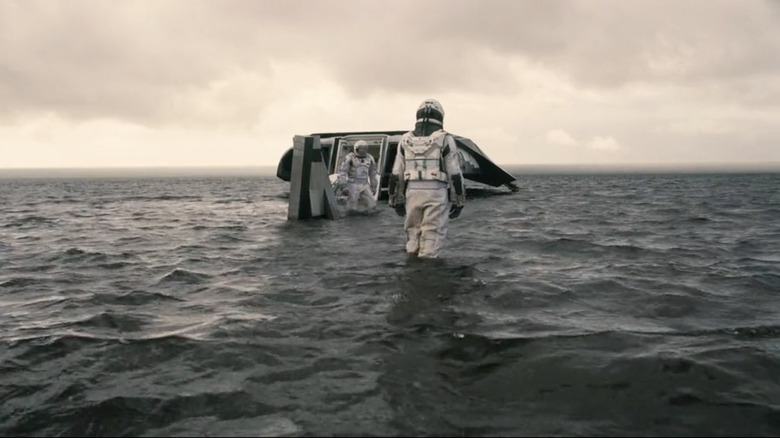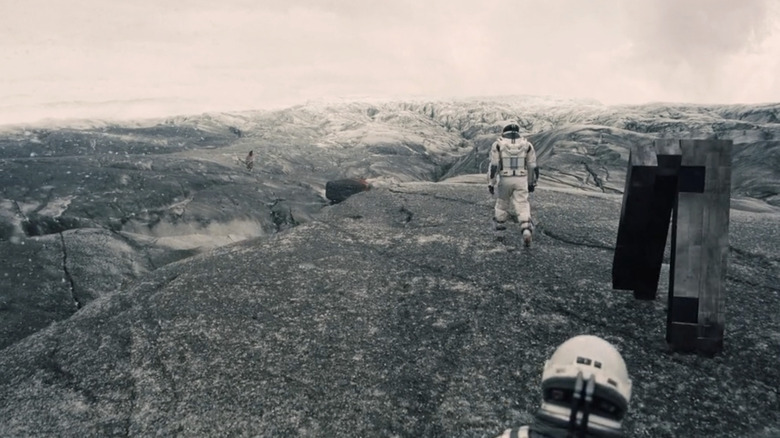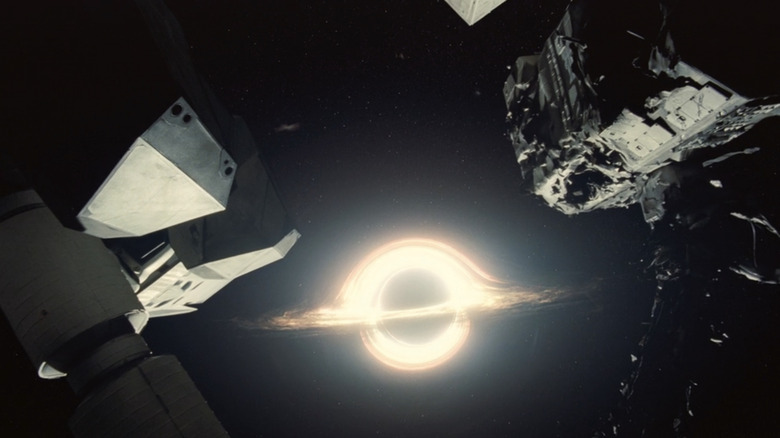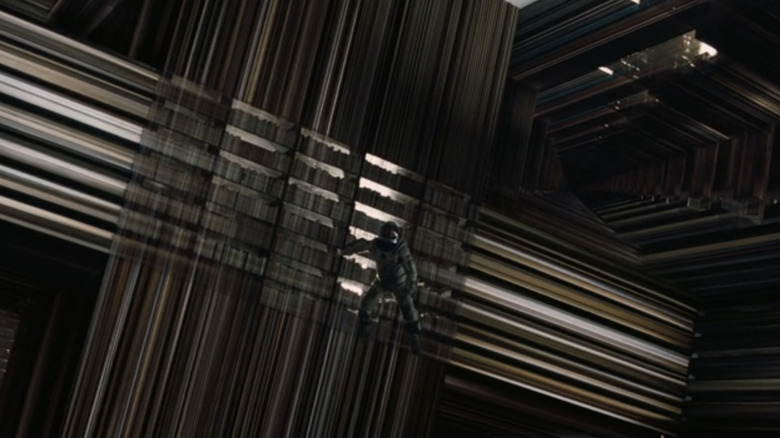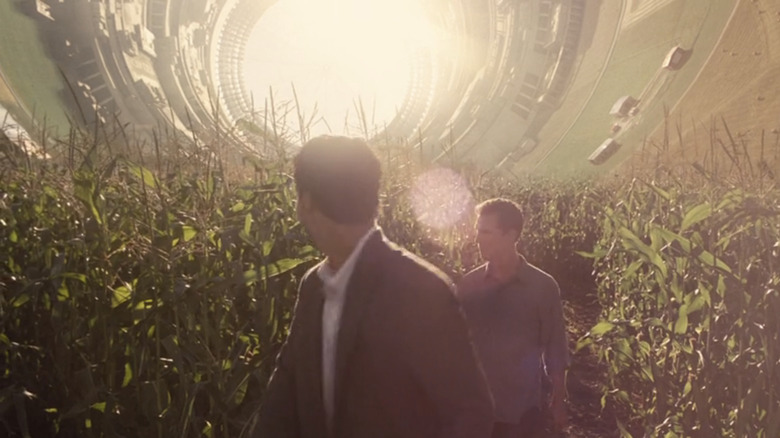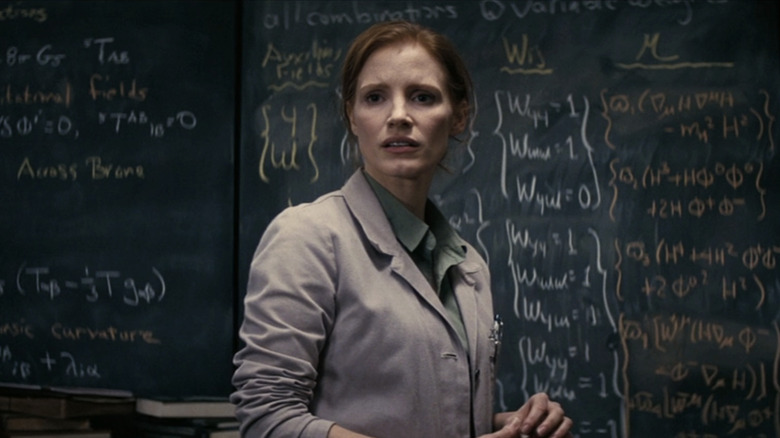The Entire Interstellar Timeline Explained
It's been about a decade since visionary director Christopher Nolan released "Interstellar," and it still instills in its viewers just as much absorption, awe, and pauses to ask what exactly is happening. The movie is half a beautiful piece of emotional drama, brought to life by a cast that includes Matthew McConaughey, Anne Hathaway, and Jessica Chastain, and half a sweeping sci-fi saga that extends from a simple corn farm to a five-dimensional tesseract built by indescribable humans from the far future. It's that second aspect of "Interstellar," the time-bending, existential riddle aspect, that we'll focus on here.
Nolan is no stranger to confusing audiences with his mind-bending, physics-heavy stories, and he seems to have a particular fascination with time. Like "Interstellar," both "Inception" and "Tenet" make time-dilation and time travel significant aspects of their plots. However, only "Interstellar," goes so far forward through the future of humanity — and once there, so far backward. If you didn't pick up on every little detail of the events in "Interstellar," you're not alone, as fan discussion about the timeline (or according to some, multiple timelines) has remained a universal constant ever since its release. We'll weigh in here by explaining the entire "Interstellar" timeline and its complicated time loop.
The Earth begins dying
The initial time period in human history that "Interstellar" explains in detail is the first half of the 21st century. According to a series of dialogue bits throughout the movie, those few decades were wracked by one global catastrophe after another, which according to schoolteacher Ms. Kelly, came about largely because of the "excess and wastefulness of the 20th century."
Alongside economic collapse, an unnamed form of blight arose in this period, killing off some crop staples entirely and leading to devastating food shortages worldwide. As a result, Earth's many nations went to war, one important enough to become almost all-consuming economically and socially, as evidenced by Cooper's (Matthew McConaughey) lament that "people were too busy fighting over food to even play baseball" and question to Professor Brand (Michael Caine) regarding NASA: "I heard they shut you down, sir, for refusing to drop bombs from the stratosphere onto starving people."
Despite the overall crisis in which humanity remained for roughly three decades, it also made a series of important scientific breakthroughs that ultimately led to its survival. In 2019, NASA discovers the wormhole near Saturn (via the Christopher Nolan-approved "The Science of Interstellar"). Following that, the military invents the first A.I. and when the food wars end, donates the remaining A.I. to NASA — three of which we meet: TARS, CASE, and KIPP. Most importantly, NASA sends probes through the wormhole and discovers 12 potentially habitable exoplanets, causing them to begin preparations for crewed exploration missions.
The age of farming
In one of the opening scenes of "Interstellar," Cooper and his kids chase a wayward malfunctioning drone, hoping to salvage its valuable solar cells. During the chase, Cooper identifies it as an Indian Air Force surveillance drone that has likely flown aimlessly for a decade because, "Delhi mission control went down, same as ours, 10 years ago." Through that and other dialogue, we can confidently place the end of the food wars roughly a decade before the present year when the movie starts. After that, nations rededicated the vast majority of their resources to growing what crops still remained, leading to an age of farming. For Cooper and his family, like so many others, this decade was uneventful, aside from the increasing dust storms and blight.
Some of those few who weren't farming, however, made massive jumps forward on behalf of all of humanity. The secret remnant of NASA (or SNASA, predicted by the legendary Barney Stinson back in 2009) launched the first crewed missions beyond our solar system, and in fact our galaxy: the Lazarus Missions. Acting on information relayed from past probe missions, 12 NASA astronauts left Earth and entered the wormhole, each headed toward a different, potentially habitable planet, their fates unknown for years.
Present day
Given Christopher Nolan's confirmation that the wormhole was discovered in 2019, which Romilly (David Gyasi) cites as "48 years ago," the present year when "Interstellar" begins is 2067. At this point, a decade into the age of farming, the surviving human population is in dire straits. As Professor Brand tells Cooper, the blight permanently destroyed "wheat seven years ago, okra this year. Now there's just corn."
The situation is so bad that the United States's many universities have been reduced to a few, small academies for the most gifted children only, hence why the school principal tells Cooper that his son Tom (Timothée Chalamet as young Tom) is destined to become a farmer, and a farmer only. Tom's sister Murph (Mackenzie Foy, as young Murph), on the other hand, is a gifted young woman with a passion for science, which helps her detect and decode the anomalies that occur in her room — the messages from Cooper in the future, which you might have noticed are the beginning of the movie's (potential) time-travel paradox.
The anomalies, perturbations of gravity, and time sent backward from Cooper manipulate and move objects in Murph's room, using Morse code to send English words and binary to send coordinates. Thanks to these messages, Cooper and Murph find themselves at the nexus of their fate — NASA's headquarters in the abandoned bunker that formerly housed NORAD.
NASA launches the Endurance
At some point in 2067, Cooper agrees to join NASA, mainly due to Professor Brand's persuasion and Cooper's longstanding dissatisfaction with a life devoid of progress. He receives a tour of their underground laboratories from Brand (Anne Hathaway), the daughter of Professor Brand and an exceptional scientist herself. Cooper eagerly jumps at their offer to pilot the Endurance, a ship whose mission is to travel through the wormhole, review the data gathered by the 12 astronauts of the Lazarus Missions, select the single best candidate for the next human home, and transmit the data back (as well as rescue any surviving Lazarus astronauts, if possible).
It only takes days to weeks after Cooper's agreement to pilot the Endurance that the ship launches. Its crew is comprised of Cooper, Brand, Romilly, and Doyle (Wes Bentley), as well as the A.I. robots TARS and CASE. The first stage of their mission is to reach the wormhole, which is still located near Saturn. With the thruster technology they possess in 2067, the journey only takes about two years, though it is long enough to warrant hyper-sleep for the human crew.
Upon waking in 2069, the crew of the Endurance enters the wormhole, only the 13th-16th humans to do so. Though the occasion is momentous, the trip through the singularity takes only about a minute. Once through, the crew assesses their options and chooses to investigate Miller's planet first, the journey to which only takes the crew a few hours or days.
Miller's planet
The expedition to Miller's planet is the first time in "Interstellar" that the crew and their loved ones back on Earth experience time dilation, in all of its grandeur and horror. Before Cooper, Brand, and Doyle decide to investigate the planet in person, Romilly warns them that its close proximity to the black hole Gargantua means that "every hour we spend on that planet will be seven years back on Earth."
The crew lands on the planet seeking Lazarus astronaut Dr. Laura Miller, whose signal is still active, transmitting data that the world contains liquid water and organic compounds. They discover the source of the signal is merely the wreckage of Miller's ship, with the explorer herself nowhere to be found. It isn't long before the Endurance crew discovers the reason why: the planet's intense gravity, brought about by Gargantua, ensures the water world is constantly wracked by skyscraper-sized tidal waves. The crew's desperate escape incurs complications, resulting in Doyle's death and leaving their overall time on the planet at around three hours.
Thanks to relativity, three hours on Miller's planet equals 23 years on Earth, bringing the date on Earth to 2092. Young Murph is now 35 (played by Jessica Chastain) and works with an aging Professor Brand at NASA working on an equation to harness gravity. Tom, meanwhile, is 40 (played by Casey Affleck), married, has already lost a child to Earth's increasing dust storms, and is on track to lose another.
Mann's world
In terms of the amount of time that passed, regardless of which planet we focus on, the Endurance crew's expedition to Mann's world is one of the least important pieces of the entire timeline. In terms of the magnitude of events that occur within that brief window, however, the expedition is easily one of the most significant. The Endurance crew spends only days on Mann's world, and because the time dilation factor between it and Earth is insignificant, only days pass on Earth, as well.
On Mann's world, the crew finds Mann (Matt Damon), wakes him from hyper-sleep, and begins preparations to establish a permanent colony on the planet's surface. Succumbing to loneliness, selfishness, and an overwhelming survival instinct, Mann betrays the crew. He reveals to Cooper that the planet isn't actually habitable and attempts to leave Cooper for dead on its surface. Romilly is killed trying to access Mann's booby-trapped A.I. and Mann attempts to hijack the Endurance. Mann fails, killing himself and destroying a large section of the Endurance.
On Earth, Professor Brand passes away, leaving Murph the last member of NASA still attempting to solve Brand's gravity equation in order to evacuate humanity en masse from the dying planet. Murph begins a relationship with NASA coworker Getty (Topher Grace), who will presumably father the many children she is later shown to have. Tom continues farming through the dust storms, all the way until (and potentially after) his second child is nearly killed by the cough the storms lead to.
Slingshot around Gargantua
Following the loss of Romilly and the irreparable damage to the Endurance, Cooper and Brand are left alone in the craft with too little life support to return to Earth. The ship is also slipping dangerously far into the unsurpassable strong gravitational pull of the black hole Gargantua, forcing Cooper to improvise with their lives (and unbeknownst to him, the future of humanity) on the line.
After assessing his options, Cooper realizes that the only way forward is to abandon any hope of returning to Earth and instead slingshot around Gargantua, using the added momentum to reach the third of their three candidate planets, Edmund's. The slingshot is successful, but only after Cooper enacts his secret plan to jettison himself and TARS from the Endurance, because as he says, "We have to shed mass if we're gonna escape that gravity." Cooper bids Brand a tearful farewell as he detaches and begins falling toward the black hole, granting Brand and CASE enough momentum to escape the gravitational pull and fly off toward Edmund's planet. Cooper clarifies the time dilation by exclaiming that it "cost us 51 years," which puts the date on Earth at 2143.
In those 51 years, Murph successfully cracks the gravity equation, allowing massive space stations to be constructed on Earth, filled with its remaining population, and easily launched into space. By the end of Cooper and Brand's slingshot, humanity has become a spacefaring civilization and Murph's central role in their salvation has made her a hero.
Into the tesseract
Though the first 2 hours and 20 minutes of "Interstellar" are undoubtedly science-fiction, they stay within relatively basic physical boundaries and are therefore easily digested by audiences at large. Then, Cooper and TARS enter the center of the Gargantua black hole, falling into the tesseract, and the simple space exploration narrative becomes, as Dr. Who famously explained it, "a big ball of wibbly wobbly, timey wimey stuff." To many fans and critics, the sequence veers a bit too far off course. Still, whether you love it or hate it, it plays with time in some interesting ways, and ultimately closes the loop on the "Interstellar" plot, both literally and figuratively.
Cooper and TARS survive their fall into the black hole and reach a kaleidoscopic space known as the tesseract. TARS describes it as a "three-dimensional space inside their five-dimensional reality" in which "time is represented here as a physical dimension." Nothing in the tesseract works the way an average person would expect it to, but Cooper and TARS are smart enough to begin unraveling its mysterious mechanics. Cooper manipulates the "strings" that line the space's physical surfaces, and in doing so, is able to send messages to both young Murph and adult Murph. The anomalies that young Murph encountered when she was 10 were the result of Cooper's time manipulation in the tesseract, as was the data that adult Murph received which allowed her to finally crack the gravity equation.
Cooper Station and the future
After being ejected from the tesseract, transported back to our home solar system, and left adrift in space near Saturn, Cooper passes out. He wakes up on Cooper Station, which he is amused to find out is named not after him, but Murph. The doctor at his bedside informs him that he's "124 years old," which puts the current year (by Earth reckoning) at 2156. By this point, humanity is completely spacefaring (aside from Brand's fledgling colony), having left Earth and filled the solar system with an array of space stations, all of them apparently containing thousands to millions of people, and all of them built as massive, rotating tubes in order to simulate gravity.
On the station, Cooper gets a glimpse of modern human life, which has time again for baseball and no longer suffers from ever-intensifying dust storms. Cooper and Murph are finally reunited, him just a few years older biologically and her around 90 years older. Unfortunately, their reunion occurs just as Murph is about to pass away, but not before the two share a heartfelt exchange in which Murph leaves Cooper with one final purpose: to find Brand and bring her back home.
We're given only the briefest glimpse of Brand before "Interstellar" ends, but it's clear that Edmund's planet is ideal. The air is breathable and the temperature acceptable, allowing Brand to set up a series of buildings, presumably nurseries to raise the thousands of fertilized ova kept onboard the Endurance for the purpose of population seeding.
The math
After the events of "Interstellar" end, we can make some assumptions about the timeline's future. Likely, in 2156-2157, Cooper will reach Brand on Edmund's planet and bring her back to humanity. Many, many years beyond that, humanity will evolve to a point in which they can manipulate time as if it were a physical dimension, and at some point beyond that, create the wormhole and tesseract to help their past selves survive. If we look backward, however, there are a number of points in the timeline we can know without assumptions, all thanks to simple math.
We know the wormhole was discovered in 2019, and that 48 years later, Cooper joins NASA, making it 2067. We know that Murph is 10 in 2067 and that, when Cooper returns from the time dilation on Miller's planet, Murph is the age Cooper was when he left; since that is 25 years later, Murph is 35 and so Cooper was 35 when he left. If he was 35 in 2067 and 124 when he woke up on Cooper Station, he must have woken up in 2156. However, since we know his slingshot around Gargantua began in 2092 and lasted 51 years, thereby ending in 2143, we have 13 missing years to account for. One plausible explanation is that Cooper spent years inside the tesseract sending out all the morse code necessary to transmit enough gravitational data to Murph to solve her equation. Whether true or not, we present to you the timeline of "Interstellar" explained, give or take 13 years.
